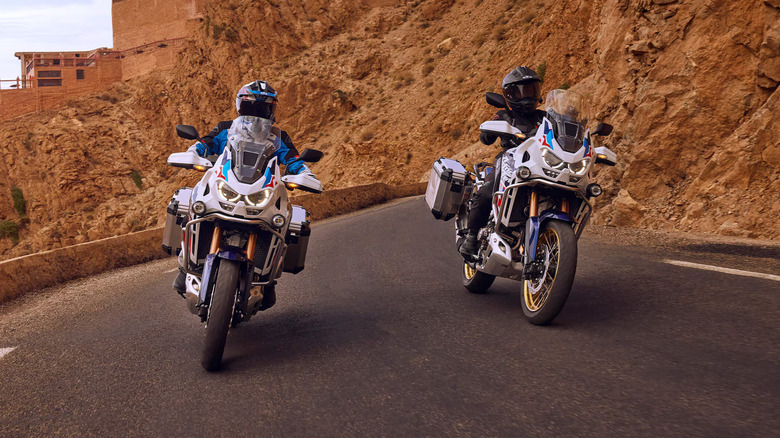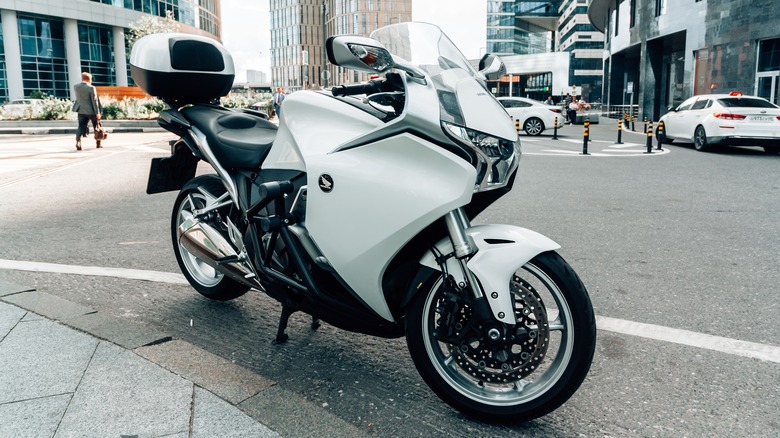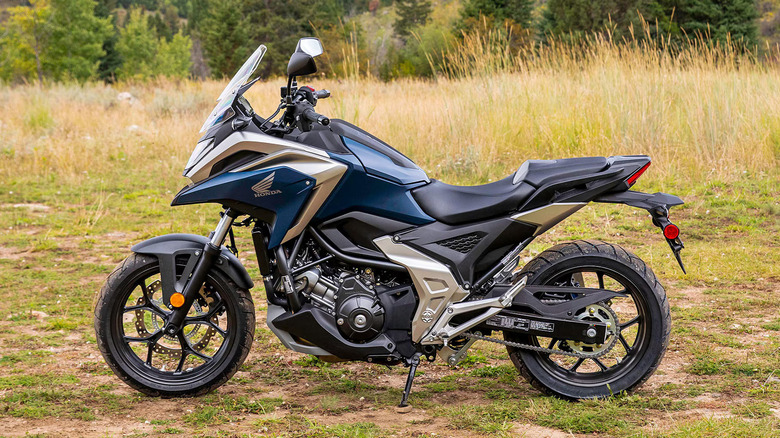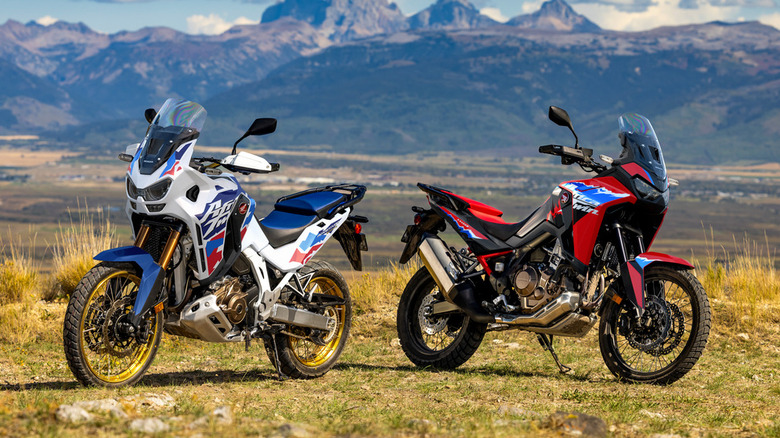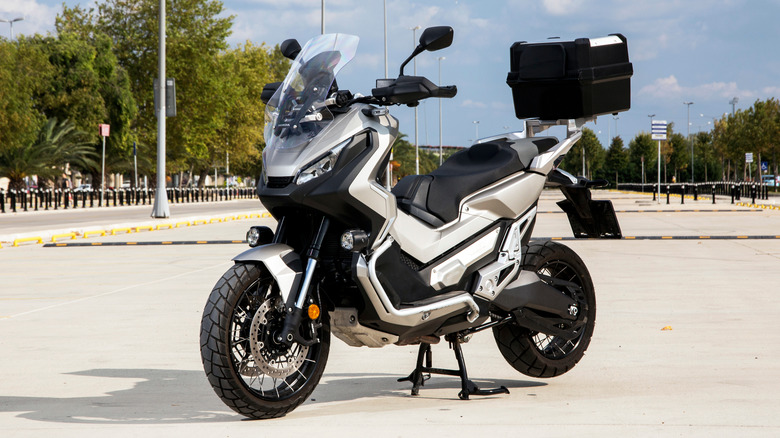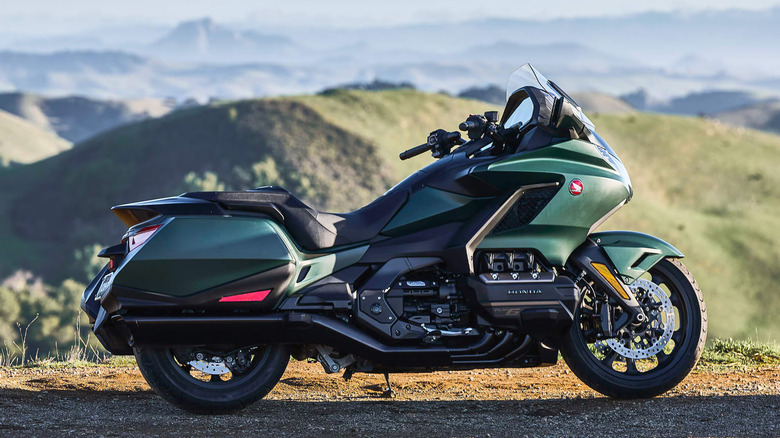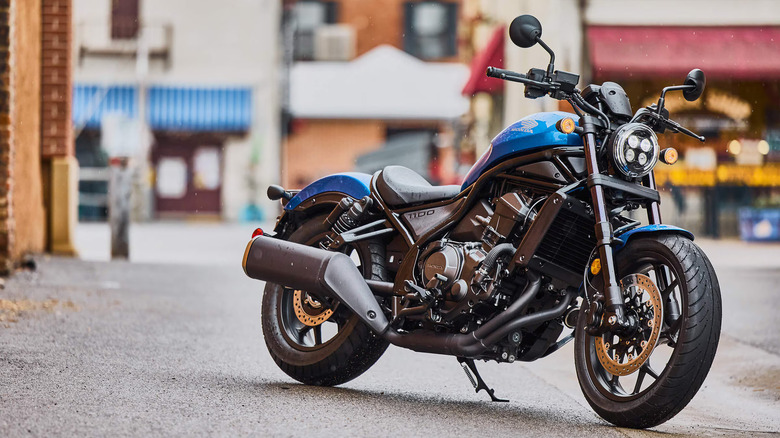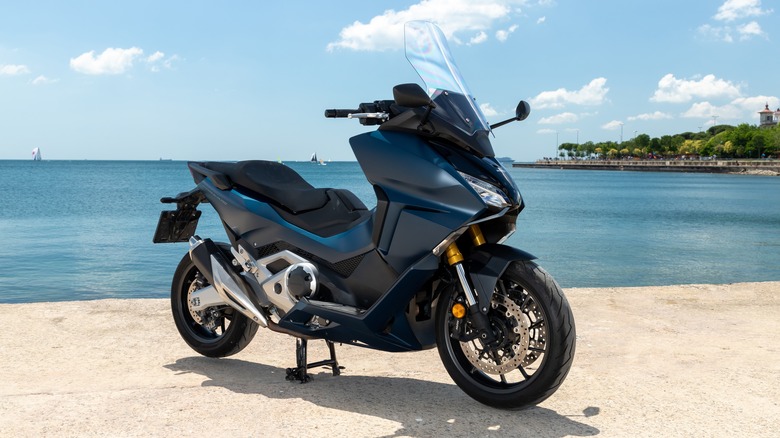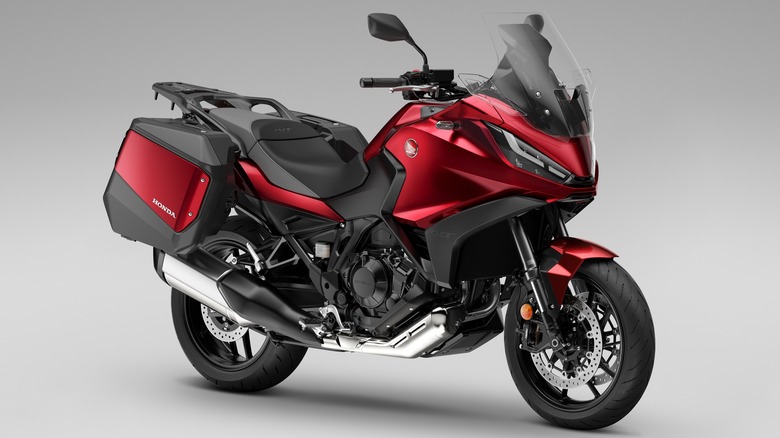Which Honda Motorcycles Have Dual Clutch Transmission (DCT)? Here's The Complete List
Honda's dual-clutch transmission has been a fixture of the motorcycle landscape for over a decade, debuting in 2010 on the VFR1200F. It had potential, but reviewers and customers of the time still preferred the manual version, with one outlet claiming that Honda sold two manual VFR1200Fs for each DCT VFR1200F.
As you might expect, Honda didn't rest on its laurels and continued to improve DCT technology over the next decade. The company improved the hardware and shifting software for the second-generation DCT in 2011, before introducing throttle-by-wire in 2018 for the third generation. This was a big step for Honda, allowing for smoother shifts, traction control — Honda Selectable Torque Control (HSTC) — and user-selectable riding modes, now a standard feature on all DCT-equipped Honda bikes.
As of 2024, Honda sells seven motorcycles with optional DCTs, or nine if you count model variants. These range from the maxi-scooter Forza 750 to the all-out touring luxury of the Gold Wing. Sadly, not all of them are available in the U.S. (one of which is the Forza 750), but we've included them here because it wouldn't be a complete list without them. Let's just hope none of you get scooter envy.
Honda VFR1200F
The motorcycle world got its first taste of Honda's DCT in 2010's VFR1200F, which offered an optional six-speed DCT alongside a six-speed manual. Launched as a replacement for the VFR800F Interceptor, the VFR1200F sported a 1,237cc V4 engine capable of producing 145 hp and 80 lb-ft of torque. The sports tourer retailed for $17,499 with the DCT — roughly $25,000 in today's money.
But the most intriguing aspect of the VFR1200F, at least for the world's motoring press, was the DCT. While dual-clutch transmissions had debuted in production cars such as the Volkswagen Golf R32 and Audi TT V6 in 2002, the technology had yet to make the leap to two wheels until the VFR1200F.
The first-gen DCT in the VFR1200F impressed outlets such as Cycle World, who appreciated the transmission's perfect up- and downshifts, even during more spirited riding on twisty roads. However, the transmission wasn't perfect, with grinding noises and clunky low-speed behavior emerging over the course of the outlet's long-term test.
Honda updated the VFR1200F in 2012, with the headline changes mainly involving the DCT. Honda engineers increased power and torque at low revs and updated the DCT logic, allowing it to learn rider habits and adapt its shift patterns to suit the rider's style. Cycle World appreciated the updates, praising the improved acceleration and better shift behavior in most riding modes — even if it stopped short of recommending the DCT. Honda discontinued the VFR1200F in 2016.
Honda NC750X DCT
In 2012, Honda introduced the second-generation DCT to its 700cc NC series motorcycles — namely the NC700X and NC700S — before releasing the NC750X in Europe a couple of years later. While the 700cc bikes are no longer in production, the NC750X DCT is still going strong in North America and Europe.
As the name suggests, the NC750X brought with it a bump in displacement to 745cc, with the liquid-cooled parallel-twin engine producing 54 hp and 50 lb-ft of torque. The 750cc bike initially launched with Honda's second-generation DCT, which promised improved shift behavior in the automatic modes. The NC750X was a Europe-only model for a few years, with North Americans having to wait until the 2018 model year to get their hands on one.
Honda increased the DCT rev limit and introduced HSTC for the NC750X DCT's American launch and has updated the bike since then. Critics praised the DCT on the 2021 model as the company's best yet, partly thanks to new riding modes introduced that year. 2021 saw the debut of Sport, Standard, and Rain modes, which adjusted engine power, shift behavior, traction control, throttle response, and engine braking. A fourth user mode allowed riders to set their preferred combination of aids and behaviors.
As of 2024, the Honda NC750X DCT is still available in North America, with a price of $9,499. Honda also released two NC-derived DCT bikes — the CTX700 and NM4 — in 2013 and 2014, respectively, although both are now discontinued.
Honda CRF1100L Africa Twin and Africa Twin Adventure Sports ES
Up until 2016, the Honda DCT had only featured in road-going motorcycles, but that all changed when Honda introduced it to the CRF1000L Africa Twin, one of the most unique adventure bikes around. The 998cc CRF1000L — and its 2018 Adventure Sports variant — was available with an optional DCT that offered two automatic shift modes and three different shift patterns.
Honda also introduced an as-yet-unseen "G" switch for the Africa Twin to help improve off-road traction. The CRF1000L also added a new incline detection feature to the DCT, which adjusted up- and downshift points when ascending and descending, respectively.
All of these improvements to the DCT carried over when Honda released new generations of the Africa Twin and Africa Twin Adventure Sports for the 2020 model year with a new 1,084cc engine and reduced weight — and a new model name, the CRF1100L. The new engine made 100 hp and 76 lb-ft of torque, which, while low compared to rivals, was more than adequate for reviewers, who also praised the DCT's smooth shifts in and out of town.
2024 brought even more improvements to both CRF1100L variants. The newest DCT in the Africa Twin and Africa Twin Adventure Sports ES boasts four settings — Drive, Sport 1, 2, and 3 — and has improved tuning for better launches and low-speed handling. The 2024 engine also runs at 10.5:1 compression and has new valve timing, helping it make 83 lb-ft of torque. The Honda Africa Twin DCT starts at $15,999, while the Adventure Sports ES DCT has a price of $18,399.
Honda X-ADV
Honda's X-ADV was one of the handful of NC-derived models Honda sold when it launched in 2016, slotting in alongside the CTX700 and NM4 from earlier in the decade. However, unlike both of those, the X-ADV "adventure scooter" is still alive and well, albeit in non-U.S. markets.
The X-ADV shares the NC750X's fundamentals, sporting the same 745cc engine — upgraded in 2021 to 58 hp and 51 lb-ft of torque — and DCT as the former, while also using the same chassis as the NC750X. Where the X-ADV differs is the "scooter" part of the equation, with the backbone design of the NC750X replaced by a feet-forward underbone seating arrangement
While the adventure-style setup makes the X-ADV one of the more unique motorcycles out there, reviews have pointed out that its off-road credentials are hampered by its small wheels and low ground clearance, even if the inclusion of a Gravel mode might suggest otherwise. That said, one aspect of the X-ADV that isn't dubious in any way is its transmission.
As with its other DCT-equipped bikes, the X-ADV's DCT has seen continuous updates over the years: The 2018 model added HSTC, while 2021 introduced riding modes like Standard, Sport, Rain, Gravel, and User, with shifting modes, traction control. The scooter's engine power settings are linked to the various riding modes and freely selectable for the User setting. The Honda X-ADV is available in Europe, the Middle East, and Asia for the equivalent of $15,000 or thereabouts.
Honda Gold Wing and Gold Wing Tour
The Honda Gold Wing is likely one of the Japanese manufacturer's most well-known models. Debuting for the 1975 model year in the U.S., the Gold Wing is often cited as one of the best touring bikes ever, going toe-to-toe with competitors like the Harley-Davidson Road Glide. The numbers back that up, too, with more than 500,000 units sold during its lifespan.
Honda's Gold Wing started life as a relatively minimal bike with a 999cc liquid-cooled, four-cylinder engine — the first-ever production example from a Japanese manufacturer. By the 1985 release of the Gold Wing GL1200, the bike had transitioned into a fully-dressed tourer. 1988 saw the debut of a 1.5-liter flat-six engine, climbing to 1.8 liters in 2001. However, the sixth-gen Gold Wing received one of the series' biggest updates yet in the form of a seven-speed DCT in 2018.
The third-generation DCT debuted on the Gold Wing Tour in 2018 and then made its way to the standard Gold Wing the following year. Unlike the DCTs on other Honda bikes, the Gold Wing has a seven-speed DCT with an overdrive for highway cruising. Four ride modes adjust engine power delivery and shift points, and new dampers offer smoother shifts. Honda also has a Walking Mode for the Gold Wing that artificially limits speeds, handy for crawling the bike around tight spaces.
Current DCT-equipped Honda Gold Wings start at $25,700 and go up to $33,000 for an airbag-equipped Gold Wing Tour.
Honda Rebel 1100 and 1100T
Honda's no stranger to twin-cylinder cruisers. Bikes like the Fury — one of the first mass-produced choppers — and the Shadow Phantom having been around for the better part of a decade, debuting around the same time as the DCT. However, despite the seemingly logical combination of an automatic transmission with a cruiser, it took until 2021 for Honda to launch a DCT cruiser: the Rebel 1100.
The Rebel 1100 sits at the top of the Rebel family, with smaller, more beginner-friendly bikes like the Rebel 500 and Rebel 300 following in its footsteps. The Rebel 1100 sports a tweaked version of the 1,083cc engine from the CFR1100L Africa Twin that makes 85 hp and 72 lb-ft of torque. Reviews praised the engine's balance and power delivery and also had good things to say about the DCT, opining that it was generally on par with a manual transmission.
As with other modern DCT-equipped bikes, the Rebel 1100 has three preset riding modes that adjust parameters such as traction and wheelie control and the six-speed DCT's shift pattern. These are Standard, Sport, and Rain, while a fourth User mode allows for more in-depth customization of the shifting and electronic assists. It also has cruise control as standard.
In 2023, Honda introduced the Rebel 1100T, an automatic motorcycle worth driving even for experienced riders. The 1100T is mechanically identical to the standard Rebel but comes with a handlebar fairing and color-matched saddlebags as standard. The Rebel 1100 DCT has a $10,149 price, while the 1100T's extras bring the price up to $11,349.
Honda Forza 750
The Forza series of scooters has been a fixture in non-U.S. markets, with the nameplate being used as far back as 2002 for a large 250cc scooter. But while the 250cc Forza was large by 2002's standards, it has nothing on the Forza 750, which Honda introduced to Europe in 2021 as a revision of its (also DCT-equipped) Integra scooter.
If you've read the previous items in our list, you can probably guess that the Forza 750 packs the same 749cc engine as the NC750X and X-ADV. The numbers are identical, too, with the engine producing 58 hp and 51 lb-ft of torque — although an ECU-limited 47-hp version is available for riders on a U.K. A2 license. The Forza 750's DCT is the standard six-speed offering present on other DCT-equipped bikes, with Standard, Sport, Rain, and User riding modes available to choose from.
The Forza 750 also gets four shifting schedules, ranging from relaxed, low-RPM behavior associated with the Rain mode to Sport mode's high-RPM and engine-braking-heavy shifting. Visordown tested the Forza 750 and came away impressed, with the sporty engine and "spectacular" DCT coming in for particular praise — alongside the Forza 750's somewhat unique combination of scooter comfort and sporty dynamics. Honda's Forza 750 is available in Europe for around $13,000.
Honda NT1100
Honda's Africa Twin has always been known as a great off-road adventure bike, but the 2024 model year introduced a slightly more road-focused version in the form of the Africa Twin Adventure Sports ES. That was an interesting enough move, but Honda decided to go one step further for the European market, launching the Africa Twin-derived NT1100 as a dedicated road-going tourer in 2022.
The NT1100 shares most of the mechanical underpinnings of the Africa Twin, housing the same 100-hp 1,084cc twin-cylinder engine from the Africa Twin inside an identical chassis — albeit with road-going suspension in place of the Africa Twin's off-road setup. As with the Africa Twin, the NT1100 has a six-speed DCT with two automatic shifting modes — the smooth D and sportier S — along with the standard multiple riding modes for determining the bike's traction control and engine behavior.
However, the NT1100 has two User modes alongside the preset Urban, Rain, and Tour modes, making for five modes in total. The NT1100 also lacks the "G" switch of the Africa Twin, which makes sense given it's not an off-road bike. Honda has kept the NT1100 the same since it launched, with 2023 and 2024 only introducing new color options — not surprising, considering the bike's popularity. After all, why mess around with a formula that works? The 2024 Honda NT1100 DCT sells for around $17,000 in Europe.
